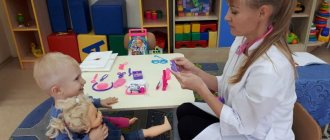The importance of play in preparing children for school
Play is a special activity that blossoms in childhood and accompanies a person throughout his life.
In modern pedagogical theory, play is considered as the leading activity for a preschool child. According to V.V. Kraevsky, the leading position of the game is determined not by the time that the child devotes to it, but by the fact that: it satisfies his basic needs; in the depths of the game other types of activities arise and develop; play makes the greatest contribution to a child’s intellectual development.
Games differ in content, characteristic features, and the place they occupy in children’s lives, their upbringing and education.
Speaking about preparing children for school, Markovi A.K. distinguishes its two sides: comprehensive education, which ensures the general level of development, and education, which forms specific knowledge, skills, and abilities of the child, which contribute to successful learning at school at the earliest stages..
Everything that can be said about the importance of play for the development of imagination, voluntary behavior, and joint activity skills of a preschooler applies in general to preparation for school. Joint activities and independent play of children with adults contribute to broad preparation for school. If a child is sufficiently developed in speech and thinking, he can control himself - act according to the instructions of an adult, restrain his momentary desires, and is able to critically evaluate the results of his work, then he is ready to go to school. In this case, the child, even without learning to read and count before school, without much effort mastered the basics of school material in the 1st grade and will successfully develop along the path of knowledge.
But if it is necessary to prepare a child for school, even from the point of view of certain skills, then a game can be used for this. The game will help your child feel the reality of school life. Of course, the child already knows about school from the stories of older people, films and books. But you can also play with it at school.
Future school life, according to E. Volkova, will be revealed to the child in a more pronounced form if in the game he is a “student” sitting at a desk, answering questions, walking during a break, returning to his desk with a bell, etc.
Since the child masters the initial skills of counting and reading (and the initial stages are the most difficult), it is necessary to move on to separating educational activities from games. An older preschooler and a younger schoolchild will spend a lot of time playing, but they must clearly distinguish between play and obligatory activities - study, work, the successful implementation of which will require willpower that overcomes their immediate desires.
In conclusion, I would like to note that the recommendations for organizing the game that you are familiar with seemed too troublesome at first glance. But I want to reassure moms and dads. Children's ability to play develops relatively quickly. Playing with your child doesn't always require a break from housework. Without spending a lot of time on developing play in a child, we provide him with full-fledged independent activity that promotes development and a happy childhood. This way, the time and effort put in by adults will pay off many times over.
However, playing with a child has another important aspect that should not be forgotten. Only through communication with a child does an adult penetrate his soul and reveal to him the world of his soul. The lack of full communication with the child will result in alienation and misunderstanding of the child by parents, and by parents and children. This may cause conflicts between parents and children.
The basis of communication between an adult and a child in the preschool period is joint activity, which is carried out mainly in the form of games. As the child grows up, adult communication with him will take other forms, but at the moment, play is the most important.
Features of mental development of children aged 6-7 years
At the age of 6-7 years, children have significant developmental reserves, but before using the existing developmental reserves, it is necessary to give a qualitative description of mental processes at this age.
V.S. Mukhina believes that perception at the age of 6-7 years loses its original affective character: Perceptual and emotional processes become differentiated. Perception becomes meaningful, focused and analytical. It prescribes voluntary actions - observation, consideration, search. At this time, language has a significant impact on the development of perception, so the child begins to actively use the names of qualities, signs, states of various objects and relationships between them. Specially organized perception contributes to a better understanding of phenomena.
In preschool age, attention by its nature is involuntary.
A state of increased attention, according to V.S. Mukhina, is associated with orientation in the external environment, with an emotional attitude towards it, with the substantive features of external impressions that cause such an increase, changes with age. The state of increased attention, as stated by V.S. Mukhin, is associated with orientation in the external environment, with an emotional attitude towards it, with the substantive features of external impressions that cause such an increase, and changes with age.
Researchers associate the turning point in the development of attention with the fact that children for the first time begin to consciously manage their attention, directing and maintaining it on certain objects.
Thus, the opportunities for the development of voluntary attention are already great at the age of 6-7 years. This is facilitated by an improvement in the planning function of the tongue, which, according to V.S. Mukhina, is a universal means of organizing attention. Language allows you to verbally identify in advance objects that are significant for a specific task and organize attention taking into account the nature of the upcoming activity.
Age-related patterns also occur in the process of memory development.
According to P.P. Blonsky, memory in older preschool age is involuntary. The child remembers better what interests him most and leaves the greatest impression. Thus, as psychologists clarify, the amount of fixed material is also determined by the emotional attitude towards a given subject or phenomenon. Compared to primary and secondary school age, and also, as noted by A.A. Smirnov, the role of involuntary memorability in 7-year-old children is somewhat reduced, but the power of memorization increases.
One of the most important achievements of an older preschooler is the development of involuntary memorization. An important feature of this age, as well as the fact that a child of 6-7 years old can be given a goal to remember this or that material. The presence of this possibility is due to the fact that, as psychologists note, the child begins to use various techniques specially designed to increase the efficiency of memorization: Repetition, semantic and associative connections of the material.
Thus, by the age of 6-7 years, the structure of memory undergoes significant changes associated with the development of voluntary forms of memorization and search. Involuntary memory, not associated with an active attitude to the current activity, turns out to be less productive, although this form of memory generally retains a leading position.
In preschool children, perception and thinking are closely interconnected, which is an argument in favor of visual-imaginative thinking that is most characteristic of this age.
According to E.E. Kravtsova, a child’s curiosity is constantly aimed at understanding the world around him and building an image of this world. The child plays, experiments, tries to establish cause-and-effect relationships and dependencies. He is forced to operate with knowledge, and when some problems arise, the child tries to solve them through real trial and error, but he can also solve problems in his head. The child imagines a real situation and acts with it as in his imagination.
Thus, visual-imaginative thinking is the main type of thinking at primary school age.
P.P. Blonsky showed that at the age of 5-6 years there is an intensive development of abilities and skills that contribute to the fact that children perceive the external environment, analyze the properties of objects and act on them in order to change them. This level of mental development, i.e. visually actual thinking is, in a sense, preparatory. It contributes to the accumulation of facts, information about the world, and the creation of a basis for the formation of ideas and concepts. In the process of visual-actual thinking, conditions for the formation of visual-mental thinking appear, which are characterized by the fact that the child solves a problem situation with the help of ideas, without resorting to practical actions.
The end of the preschool period is characterized by the predominance of visual-figurative thinking or visual-schematic thinking.
The achievement of this stage of the child’s mental development is reflected in the schematic nature of the child’s drawing and in the ability to use schematic images when solving problems.
Psychologists argue that visual-imaginative thinking is the basis of logical thinking, which is associated with the use and transformation of concepts.
Thus, a child aged 6-7 years can approach a problem situation in three ways: through visual-actual, visual-imaginative and logical thinking.
S.D. Rubinstein, D.B. Elkonin argue that preschool age should be considered only as a period when the intensive formation of logical thinking begins, as if determining the next perspective of mental development.
In preschool age, the process of language acquisition is largely completed: by the age of 7, language becomes a means of communication and thinking of the child, also an object of conscious learning, since in preparation for school, learning to read and write begins; The phonetic side of the language develops. Younger preschoolers are aware of the peculiarities of their pronunciation, but they still have earlier modes of perception of sounds, thanks to which they recognize incorrectly pronounced children's words. By the end of preschool age, the process of phonemic development and the development of the grammatical structure of speech is completed. Children learn subtle patterns of morphological and syntactic order. The acquisition of grammatical forms of speech and the development of more active words allows them to move on to the specifics of language at the end of preschool age.
Research by N.G. Salmina show that children aged 6-7 years have mastered all forms of oral speech that are inherent in an adult. They develop elaborate messages, monologues, stories and dialogic speech in communication with colleagues, including instructions, assessment, coordination of play activities.



